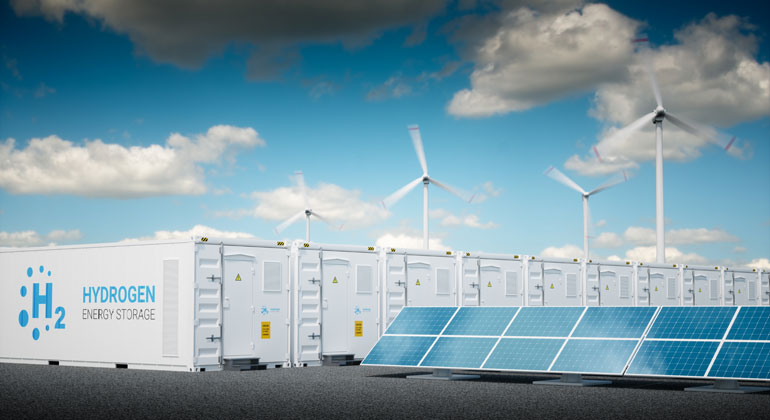Global Hydrogen Atlas Shows Potential Import Countries for Germany
In the long term, Germany will have to import a large proportion of its green hydrogen and hydrogen-based synthesis products to meet its future needs.
In the “HYPAT” project, a consortium of scientists and development workers have created a global hydrogen potential atlas that identifies and analyzes sustainable locations for the green hydrogen economy of the future. For the first time, a comprehensive overview of potential partner countries for coop-erative development with Germany is presented in detail, including potential trade volumes, production and transportation costs for 2030 and 2050.
As part of the project, the Fraunhofer Institute for Solar Energy Systems ISE primarily carried out techno-economic analyses of potential locations for green hydrogen production and the export of possible Power-to-X products. The team performed a detailed cost analysis along the value chain for imports from Brazil, Morocco, Canada, Ukraine, and the United Arab Emirates. The researchers also considered the needs of the partner countries, for example, the sustainable coverage of their own energy demand, the achievement of their climate targets and compliance with specific sustainability criteria for the hydrogen economy.
Hydrogen Imports to Germany Simulated
Using the “H2ProSim” simulation tool, the team analyzed the import of five Power-to-X products (liquid hydrogen, ammonia, liquid organic hydrogen carriers, methanol and Fischer-Tropsch products) by ship. While the highest share of cost, ranging from two thirds to three quarters, is the hydrogen production itself, the share for synthesis, storage and transportation vary according to the product and production volume.
Depending on the chosen development scenario, the study considers import costs of around 3.50 to 6.50 euros per kilogram of hydrogen possible in 2030 and 2 to 4.50 euros per kilogram in 2050 (see figure). In principle, most of the countries analyzed can realize costs at a comparable level.
The question of whether transport by ship or pipeline is more cost-effective must be answered individually for each country. While ship transport allows greater flexibility for market participants, pipeline transport requires strategic partnerships on the one hand and dependencies on the other, which is not ideal.
Liquid hydrogen is emerging as the most cost-effective option for importing pure hydrogen by ship in the long term, although this technology is not yet available on the market. Among the Power-to-X products, ammonia is the most promising candidate, followed by methanol and Fischer-Tropsch synthesis products. The authors of the study therefore recommend the promotion of ammonia as the easiest and cheapest product to realize in the short and medium term. In addition, the development of liquid hydrogen technologies should be accelerated as potentially the most economically attractive option for hydrogen imports.
Positive effects on exporting countries
Together with their project partners, the researchers at Fraunhofer ISE also looked at environmental aspects, sustainability criteria and social and economic development opportunities for the exporting countries, such as the expected local value creation, job creation and other co-benefits. Aside from this, the hydrogen-exporting countries benefit from the trade, in that the required renewable installations for hydrogen production can lead to a faster energy transition and lower electricity costs. However, this synergy effect can weaken if export volumes increase, as it may exhaust the renewable energy potential of the exporting country and eventually cause their electricity price to increase. “We therefore recommend addressing the potential effects on the local energy transition with the exporting countries at an early stage to avoid misguided developments during the infrastructure expansion. For some countries, upper limits on export volumes have become clear and these should be taken into account,” explains Ombeni Ranzmeyer, one of the study’s authors from Fraunhofer ISE. Countries that are able to move quickly to defossilize their industry and energy sector should be given preference.
Sustainable water supply for hydrogen production
To produce one kilogram of hydrogen, electrolyzers currently require 15 to 20 kilograms of fresh water, including losses and cooling. Water is also needed to generate electricity, albeit a much smaller amount – either as a coolant or for cleaning PV systems – and, depending on the product, for the synthesis process. In regions with low freshwater reserves, alternatives such as seawater desalination or pipelines must be included in the planning of sustainable hydrogen projects. In the HYPAT project, the Fraunhofer ISE team analyzed the water costs for potential Power-to-X sites in Morocco as an example, combining geodata with the costs of water treatment technologies and pipelines. The study shows that a minimum size of the electrolyzer project must be achieved for the economic efficiency of the water supply and transport, which varies depending on the region. For Morocco, the investment costs for the water supply ranged between 0.012 and 0.245 euros per kilogram of hydrogen produced. These costs are very low compared to the other system costs, e.g. for electrolysis. “With this study, we were able to create a balanced framework for the evaluation of water costs for electrolysis and PtX production models that included sustainability aspects for all sectors relying on the precious resource of water,” says study author Friedrich Mendler.
- Study (in German) [ PDF 0.2 MB ]
- ISE Project Website
- Project report HYPAT
- Main project page
- hydrogen import costs 2050 [ PNG 0.06 MB ]
- hydrogen import costs 2030 [ PNG 0.06 MB ]








